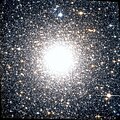NGC 6388
Appearance
| NGC 6388 | |
|---|---|
 Credit: MPG/ESO telescope | |
| Observation data (J2000 epoch) | |
| Class | III[1][2] |
| Constellation | Scorpius[2] |
| Right ascension | 17h 36m 17.461s[3][4] |
| Declination | −44° 44′ 08.34″[3][4] |
| Distance | 32.3 kilolight-years (10 kiloparsecs)[2] |
| Apparent magnitude (V) | 6.72[2] |
| Apparent dimensions (V) | 6.2 arcmins[2] |
| Physical characteristics | |
| Mass | 2.17×106[5] M☉ |
| Tidal radius | 6.21 arcmins[6] |
| VHB | 16.85[6] |
| Metallicity | = -0.55[6] dex |
NGC 6388 is a globular cluster located in the constellation Scorpius. The cluster was discovered by Scottish astronomer James Dunlop on May 13, 1826 using a 22.86 cm (9 in) reflector telescope. Due to its moderate apparent magnitude (+6.72), a telescope is required to see it.
Gallery
References
- ^ Shapley, Harlow; Sawyer, Helen B. (August 1927). "A Classification of Globular Clusters". Harvard College Observatory Bulletin. 849 (849): 11–14. Bibcode:1927BHarO.849...11S.
- ^ a b c d e "Students for the Exploration and Development of Space (NCG 6388)". Retrieved 26 September 2015.
- ^ a b "NGC 6388". SIMBAD. Centre de données astronomiques de Strasbourg. Retrieved 27 September 2015.
- ^ a b "NASA/IPAC Extragalactic Database (NGC 6388)". Retrieved 27 September 2015.
- ^ Boyles, J.; et al. (November 2011), "Young Radio Pulsars in Galactic Globular Clusters", The Astrophysical Journal, 742 (1): 51, arXiv:1108.4402, Bibcode:2011ApJ...742...51B, doi:10.1088/0004-637X/742/1/51.
- ^ a b c "Galactic Globular Clusters Database (NCG 6388)". Retrieved 26 September 2015.
External links
 Media related to NGC 6388 at Wikimedia Commons
Media related to NGC 6388 at Wikimedia Commons

![{\displaystyle {\begin{smallmatrix}\left[{\ce {Fe}}/{\ce {H}}\right]\end{smallmatrix}}}](https://wikimedia.org/api/rest_v1/media/math/render/svg/4c0821bd80891e071c08e7c7ee8e022baedf522c)

